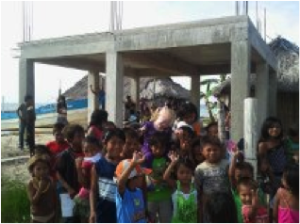ORIGIN: Starting the Conversation

Fulfilling A Dream
Over 30 years ago, a man named Allen Sappington was called to be a missionary to the Kuna, a people indigenous to Panama and Colombia. The Kuna live primarily in a string of islands in the Caribbean called the San Blas Islands. When he was called to be a missionary, Allen also received a vision of a building that he was going to build on the island of Nalunega. The building would be used a mission for the Kuna, as well as living quarters for Sappington and his wife, Kathy.
Our pastor, Ron Spradlin of Abundant Rain Ministries, first met Allen on a mission trip to Nalunega. Allen had been living there for over 30 years – and Kathy over 15 years – in a hut without running water or electricity. Hanging on the wall was a drawing of a two-story building. It was the building that Allen had envisioned 30 years earlier.
The next time Pastor Ron was on the island, the drawing was gone. Allen had given up on his dream. Pastor Ron then knew what God wanted him to do: he needed to build that building for the Kuna – and for Allen and Kathy. He returned to Oklahoma and shared this mission with the congregation of Abundant Rain, which is how I got involved with the project.
I made my first trip to the San Blas Islands in September, 2012. The Kuna men were eager to learn about construction. One had spent time in Panama and had learned some construction techniques, so we nicknamed him “the carpenter.”
The building was laid out on a 20 foot by 20 foot grid and would be built of concrete, which was a very slow and labor-intensive process. Cement was purchased in Panama City and trucked through the rainforest (which they call the frontier) to the coast. There, the cement was loaded onto canon-like boats and shipped across the Caribbean to Nalunega. Sand was taken from the island beaches and rocks in a variety of sizes were brought in from the coast of Panama. The rocks were broken down by a hammer into smaller sizes and used as aggregate. All of the concrete was mixed in a 6 cubic foot mixer that could hold a 94-pound bag of cement, 15 gallons of sand, 25 gallons of aggregate and seven to eight gallons of water.
There were many other challenges as well. Rebar had to be cut and bent by hand. Epoxy coated bars weren’t available, so all of the rebar was painted with enamel. The wood used for the formwork was harvested from the rainforest. It was soft, had a musty smell and became brittle when dried, which was problematic for reuse as forming.
Once a batch of concrete was mixed, it was poured into a wheelbarrow and rolled over to the area being poured. The concrete would then be shoveled into rope-handled, five-gallon buckets and carried to be placed. Toward the end of the day, the crew could only carry buckets with two shovelfuls in them. Because of the time-consuming nature of this process, it would take up to five hours to pour a 10 foot by 20 foot section of 5-inch thick elevated slab.
To provide water to the building, we installed a gravity-fed system with a 300-gallon water tower. The water tower is filled with water from a stream on the mainland of Panama. To collect the water, the Kunas place two 55-gallon plastic drums in a dugout canoe and row to the mainland to fill them from the stream. When they are full, they bring them back to the island and use a pump we brought them to fill the water tower. The plumbing we installed consisted of a sink, shower and toilet. It was quite funny to watch the Kuna flush the toilet and watch the water swirl!
Children are our future and we are called on to feed them. Once the dream of constructing the building was fulfilled, we turned to the mission of feeding the Kuna children every day. We blocked in a 10 foot by 20 foot room for food storage. The room is stocked with USDA-approved food packets with an extended shelf life. The packets contain a mixture of rice, soy, dehydrated vegetables, and 21 vitamins and minerals, and they are cooked with water.
The work we did on Nalunega was important for the Kuna and rewarding for all of us who helped. If you’re interested in learning more about the Kuna, please visit www1.american.edu/ted/kuna.htm.

There are no comments.